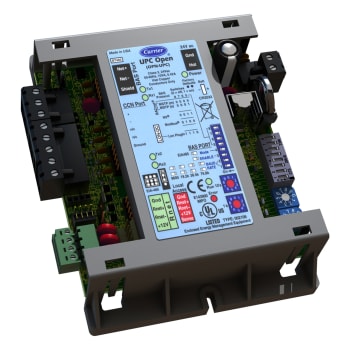i-Vu® UPC Open
OPN-UPC
Product Integrated Controller
Integrated BACnet® Communications Card
Connecting your Carrier equipment to a BACnet MS/TP network has never been easier. Simply connect the UPC Open to the BACnet network, and your Carrier equipment is ready to integrate seamlessly into the i-Vu Building Automation System or any other BACnet Building Automation System.
Factory-Installed Features
- Factory-installed option on rooftops, air-cooled chillers, and water-cooled chillers
- Pre-programmed to share equipment data with any BACnet Building Automation System - no on-site engineering required
- Supports Carrier communicating space sensors with field programming:
- Ideal for single zone rooftop applications
- Available in 4 flavors, 2 of which have large, easy-to-read LCD displays
- Feature a hidden communication port for network commissioning
- Supports plug-and-play connectivity to Carrier’s i-Vu Building Automation System:
- Integrated air source linkage algorithm
- Built-in user interface graphics, diagnostic trends and alarms
- Built-in demand limiting and inherent support for i-Vu Tenant Billing
Field-Installed Features
- Library of CCN to BACnet mapping templates available for common Carrier equipment, or create your own template using the Snap graphical programming tool
- Integrated air source linkage algorithm for plug-and-play connectivity to the i-Vu Building Automation System
- Supports demand limiting and i-Vu Tenant Billing
| Communication Ports | BAS port (Port 1A): EIA-485 port for BACnet MS/TP communications, Modbus communications or N2 communications (future). Baud rate is DIP switch selectable.
LON-OC Port: For connecting a LON Option Card (future) Local Access Port: For system start-up and troubleshooting (115.2 kbps) Rnet Port: For connecting Carrier communicating space sensors |
| Protection | Incoming power and network connections are protected by non-replaceable internal solidstate polyswitches that reset themselves when the condition that causes a fault returns to normal. The power, network, input, and output connections are also protected against voltage transient and surge events. |
| Real Time Clock | Battery-backed real time clock |
| Battery | 10-year Lithium CR2032 battery provides a minimum of 10,000 hours of trend data and time retention during power outages. |
| Status Indicators | LED status indicators for power, network communication, run status and errors. |
| Controller Addressing | Rotary DIP switches set BACnet MS/TP MAC address of controller |
| Listed By | UL-916 (Canadian Std C22.2 No. 205-M1983), CE, FCC Part 15-Subpart B-Class A |
| Environmental Operating Range | Operating: -22° to 150°F (-30° to 66°C), 10-95% relative humidity, non-condensing
Storage: -24°F to 140°F (-30° to 60°C), 10-95% relative humidity, non-condensing |
| Power Requirements | 24VAC +/- 10%, 50-60Hz
10VA power consumption 26VDC (25V min, 30V max) Single Class 2 source only, 100VA or less |
| Dimensions | Length: 5-3/16” (13.2 cm)
Width: 4-1/8” (10.5 cm) Depth: 2” (5.1 cm) Weight: 0.44 lbs. (0.20 kg) |
Factory-Installed Features
- Factory-installed option on rooftops, air-cooled chillers, and water-cooled chillers
- Pre-programmed to share equipment data with any BACnet Building Automation System - no on-site engineering required
- Supports Carrier communicating space sensors with field programming:
- Ideal for single zone rooftop applications
- Available in 4 flavors, 2 of which have large, easy-to-read LCD displays
- Feature a hidden communication port for network commissioning
- Supports plug-and-play connectivity to Carrier’s i-Vu Building Automation System:
- Integrated air source linkage algorithm
- Built-in user interface graphics, diagnostic trends and alarms
- Built-in demand limiting and inherent support for i-Vu Tenant Billing
Field-Installed Features
- Library of CCN to BACnet mapping templates available for common Carrier equipment, or create your own template using the Snap graphical programming tool
- Integrated air source linkage algorithm for plug-and-play connectivity to the i-Vu Building Automation System
- Supports demand limiting and i-Vu Tenant Billing
| Communication Ports | BAS port (Port 1A): EIA-485 port for BACnet MS/TP communications, Modbus communications or N2 communications (future). Baud rate is DIP switch selectable.
LON-OC Port: For connecting a LON Option Card (future) Local Access Port: For system start-up and troubleshooting (115.2 kbps) Rnet Port: For connecting Carrier communicating space sensors |
| Protection | Incoming power and network connections are protected by non-replaceable internal solidstate polyswitches that reset themselves when the condition that causes a fault returns to normal. The power, network, input, and output connections are also protected against voltage transient and surge events. |
| Real Time Clock | Battery-backed real time clock |
| Battery | 10-year Lithium CR2032 battery provides a minimum of 10,000 hours of trend data and time retention during power outages. |
| Status Indicators | LED status indicators for power, network communication, run status and errors. |
| Controller Addressing | Rotary DIP switches set BACnet MS/TP MAC address of controller |
| Listed By | UL-916 (Canadian Std C22.2 No. 205-M1983), CE, FCC Part 15-Subpart B-Class A |
| Environmental Operating Range | Operating: -22° to 150°F (-30° to 66°C), 10-95% relative humidity, non-condensing
Storage: -24°F to 140°F (-30° to 60°C), 10-95% relative humidity, non-condensing |
| Power Requirements | 24VAC +/- 10%, 50-60Hz
10VA power consumption 26VDC (25V min, 30V max) Single Class 2 source only, 100VA or less |
| Dimensions | Length: 5-3/16” (13.2 cm)
Width: 4-1/8” (10.5 cm) Depth: 2” (5.1 cm) Weight: 0.44 lbs. (0.20 kg) |
California residents please see Proposition 65


